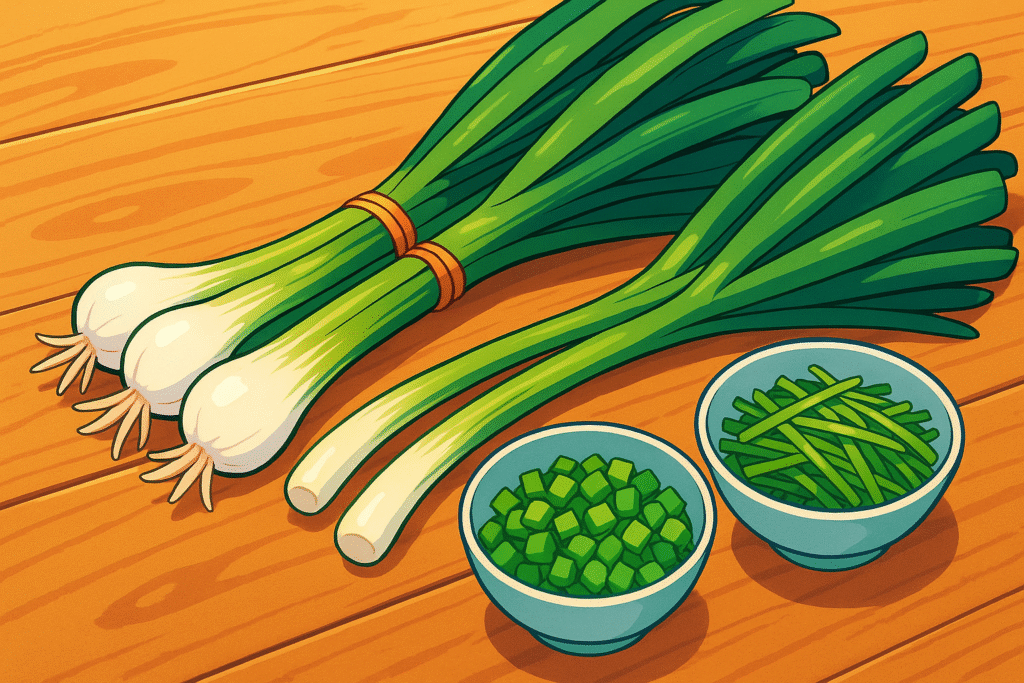Spring Onions (Scallions) (Allium fistulosum)

About Spring Onions (Scallions)
Spring onions, known botanically as Allium fistulosum, are slender alliums prized for their vibrant, fresh flavor and versatility. Sometimes called scallions or green onions in English, spring onions have slender green stalks and small, often white or sometimes purple-tinged bulbs. Their flavor is milder than mature onions but punchier than chives: fresh, grassy, with a subtle bite and sweet undertones when cooked. Used raw, they brighten salads, salsas, and noodle dishes; cooked, they add depth to stir-fries, soups, omelets, and flatbreads. Spring onions transcend boundaries, making appearances from Chinese cong you bing (scallion pancakes) to Mexican cebollitas asadas and Indian kanda bhaji. Their charm lies in their edible, flavorful entirety—all parts, from root to leaf, are put to use in kitchens around the world.
The History of Spring Onions (Scallions)
Spring onions boast millennia of culinary history, first cultivated in Central Asia, with records stretching back to ancient China and Egypt. Their close cousins, bulb onions and chives, share the same broader allium ancestry. In China, spring onions have been a kitchen staple and symbolic ingredient for centuries, woven into Emperor Yang’s feasts, and Ouyang Xiu’s poems alike. They spread to Persia, the Indian subcontinent, the Mediterranean, and later Europe, adapting to countless cuisines. Today, they play prominent roles in East Asian, Mediterranean, South Asian, and Latin American kitchens, where cooks value their early, tender harvest and quick-cooking adaptability.
The Science of Spring Onions (Scallions)
Unlike bulb onions (Allium cepa), spring onions belong to the species Allium fistulosum, bred for elongated, hollow stalks and less pronounced bulbs. Their unique bite is owed to sulfur-containing compounds, particularly thiosulfinates, also responsible for the mild pungency and health-promoting antioxidants. Spring onions are low in calories, high in vitamins K and C, and provide fiber and trace minerals such as folate and potassium. The green tops are particularly rich in chlorophyll and carotenoids, adding nutritional value along with color. Enzymatic action that releases the “onion” aroma is triggered most when the vegetable is cut, which is why fresh-cut spring onions smell so inviting.
The Geography of Spring Onions (Scallions)
Spring onions thrive in temperate and subtropical climates and are grown globally, from the fields of northern China and Korea to Mediterranean gardens, Indian states, and Andean valleys. In East Asia, they’re often part of the staple crop rotation—playing a key role in dishes from Japanese negiyaki to Thai gai pad king. Mexican markets offer fresh “cebollitas” year-round, typically grilled whole and served at taquerías. European and Middle Eastern cooks favor spring onions for fresh salads or savory pancakes, using local varieties adapted to their soil and climate. Flavor intensity, stalk thickness, and bulb size vary by region and cultivation method.
Varieties of Spring Onions (Scallions)
Welsh Onion (Allium fistulosum)
Despite its name, this is the classic spring onion of East Asian cuisine—robust, with long, hollow green stalks and almost no bulb. Used abundantly in Chinese and Japanese foods.
Japanese Negi
A larger, slightly thicker spring onion with white stalks prized for their sweetness and often used grilled or sliced into soups (as in miso soup and nabe).
Red Spring Onion
Slightly purplish at the base, with a crisper texture and sharper flavor. Used widely in salads and as a fresh garnish in Indian, Middle Eastern, and Mediterranean dishes.
Cebollita (Latin American Spring Onion)
Grown throughout Latin America; larger and more bulbous. These are often grilled whole (“cebollitas asadas”) and paired with roasted meats.
Green Onion or Salad Onion
A common, mild variety harvested before bulb development. Popular in European salads and for fresh garnishes.
FAQs All your questions about Spring Onions (Scallions): answered
Are spring onions and green onions the same?
Mostly, yes—though names vary regionally. “Green onion” and “scallion” generally refer to immature onions or Allium fistulosum with undeveloped bulbs. True “spring onions” sometimes have a small bulb and more pungency but are used similarly.
Should you eat the green tops and white bottoms?
Absolutely. Both are edible and delicious—the white segment is stronger in flavor and ideal for stir-fries or grilling, while the green tops are milder, perfect raw as a garnish or in salads.
Can you grow spring onions at home from scraps?
Yes. Place the root ends in water or moist soil and they’ll quickly sprout new greens. In temperate zones, they grow year-round in pots or the garden.
How are spring onions used differently around the world?
In China and Korea, they flavor stews, pancakes, and barbecue dips. India folds chopped spring onion into fritters or curries. Latin American cuisines grill them whole. In Europe and the Middle East, they brighten salads and savory pastries.
Do spring onions lose flavor when cooked?
Some sharpness softens, but cooking brings out sweetness and a mild, caramelized complexity—especially when grilled or roasted.